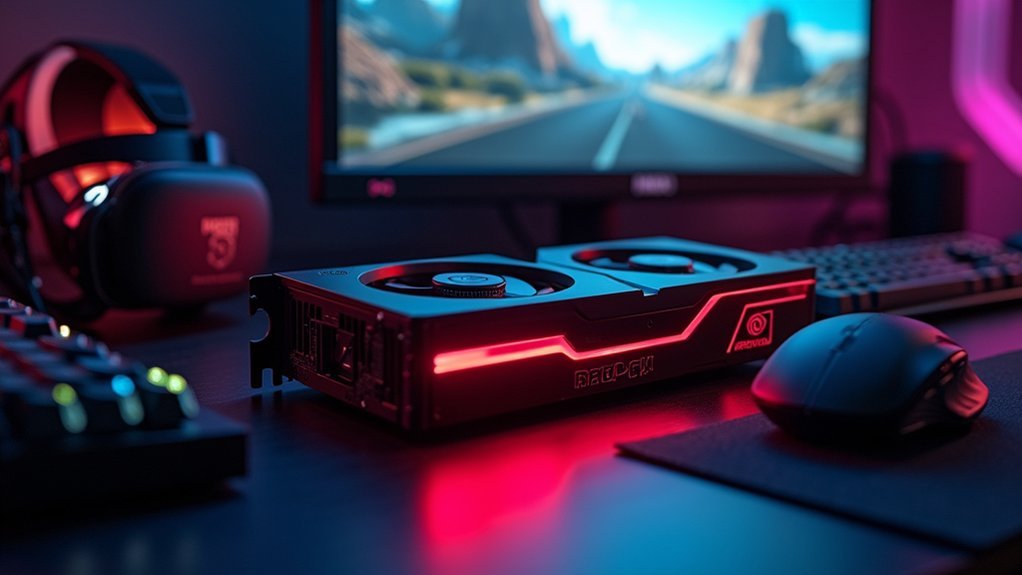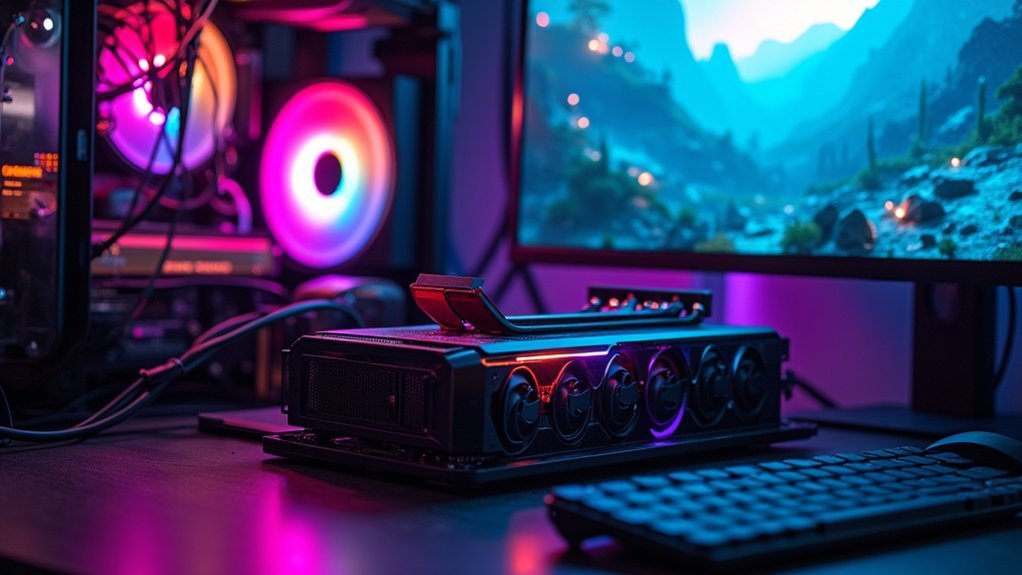You’ll need a powerful GPU that delivers at least 90 FPS to prevent motion sickness in VR gaming. Modern NVIDIA RTX cards like the 4070 Ti or AMD Radeon RX 7900 GRE provide the essential 12-16GB VRAM required for high-resolution VR headsets. Your graphics card must render two simultaneous high-resolution images while maintaining sub-20ms latency for smooth gameplay. Premium options like the RTX 4090 offer exceptional performance with ray tracing capabilities. Understanding these specifications will transform your virtual experiences completely.
What Is a Graphics Processing Unit and Why It Matters for VR

When you’re diving into virtual reality gaming, your GPU becomes the powerhouse that transforms digital worlds into immersive experiences you can actually feel present in. A Graphics Processing Unit is a specialized electronic circuit that accelerates image creation and rendering, making it absolutely critical for immersive gaming.
Your GPU directly impacts VR performance through frame rates—you’ll need a minimum of 90 FPS to avoid motion sickness and guarantee smooth gameplay. Modern cards like NVIDIA GeForce RTX series feature dedicated cores for real-time ray tracing, creating realistic lighting and shadows that enhance your virtual environment.
You’ll also need high VRAM (12GB or more) since VR renders two high-resolution images simultaneously—one for each eye—dramatically increasing the graphical load your system must handle.
Essential VR Performance Requirements and Frame Rate Standards
When you’re building a VR setup, your GPU must meet specific performance thresholds to deliver smooth, comfortable gameplay.
You’ll need a graphics card that can consistently push 90 FPS or higher while maintaining ultra-low latency below 20 milliseconds.
These aren’t just recommendations—they’re essential requirements that determine whether you’ll enjoy immersive virtual worlds or suffer from motion sickness and visual stuttering.
VR GPU Requirements
Although standard gaming might forgive occasional frame drops, VR gaming demands unwavering performance standards that’ll make or break your immersive experience.
You’ll need a GPU delivering consistent 90+ FPS, with premium headsets requiring 120 FPS for ideal comfort. Your graphics card must pack at least 8GB VRAM to handle complex VR environments without stuttering.
NVIDIA’s GeForce RTX 3060 and higher models represent the sweet spot for VR performance, offering advanced features like ray tracing and DLSS that enhance visual quality while maintaining frame rates.
These GPUs include NVIDIA Reflex technology, dramatically reducing input lag that’s critical for responsive VR gameplay.
Don’t overlook compatibility – verify your chosen GPU has proper HDMI or DisplayPort connections matching your headset’s requirements and meets manufacturer specifications.
Frame Rate Standards
While standard gaming operates comfortably at 60 FPS, VR gaming’s performance thresholds demand considerably higher standards that directly impact your physical comfort and immersion quality.
You’ll need minimum 90 FPS for VR to prevent motion sickness, though higher frame rates deliver smoother experiences. For competitive gaming, you should target 144 FPS or higher to maximize responsiveness.
Your monitor’s refresh rates determine ideal performance targets—144Hz displays require matching frame rates to eliminate screen tearing and utilize full capabilities.
High refresh monitors won’t deliver benefits without corresponding GPU power.
DLSS technology can boost your frame rates up to 70% in supported titles without compromising visual quality.
However, consistent performance matters most—fluctuating frame rates below your target create stuttering that destroys immersion and competitive advantage.
Top NVIDIA GeForce RTX Graphics Cards for Virtual Reality

You’ll need a powerful NVIDIA GeForce RTX graphics card to meet VR’s demanding performance requirements and achieve smooth, immersive gameplay.
RTX cards offer specialized VR features like DLSS 4 and advanced ray tracing that greatly enhance visual quality and frame rates in virtual environments.
Let’s examine the best RTX models that’ll deliver exceptional VR performance across different budgets and resolution targets.
VR Performance Requirements
When diving into virtual reality gaming, your graphics card becomes the cornerstone of whether you’ll experience smooth, immersive worlds or stuttering disappointment. RTX graphics processing demands vary greatly across VR titles, making performance and value considerations essential for your setup.
| GPU Model | CUDA Cores | Memory | VR Capability |
|---|---|---|---|
| RTX 4060 Ti | 7,680 | 8GB GDDR6 | 1440p VR |
| RTX 4070 Ti | 8,448 | 16GB GDDR6X | High-fidelity VR |
| RTX 4090 | 16,384 | 24GB GDDR6X | Exceptional VR |
Your power supply requirements scale with GPU performance. The RTX 4090 needs high-end PSU capacity, while the 4060 Ti offers more modest power demands. Ray tracing cores in newer RTX models enhance VR gaming realism, with DLSS technology boosting frame rates for responsive virtual environments.
RTX VR Features
NVIDIA’s RTX graphics cards transform VR gaming through cutting-edge technologies that directly address virtual reality’s most demanding requirements.
You’ll experience unprecedented visual fidelity with real-time ray tracing, delivering realistic lighting, shadows, and reflections that make immersive environments feel genuinely lifelike.
NVIDIA DLSS technology upscales lower-resolution images while maintaining smooth frame rates, ensuring your VR sessions remain fluid without compromising graphic quality.
The RTX 5000 series introduces Multi Frame Generation, boosting frame rates in supported VR titles by creating additional frames.
You’ll notice markedly enhanced fluidity during intense VR interactions.
NVIDIA Reflex technology minimizes latency, providing responsive gameplay that’s vital for maintaining immersion and preventing motion sickness.
These combined features make RTX cards ideal for demanding VR applications.
Best RTX Models
Selecting the right RTX graphics card determines whether you’ll enjoy seamless VR gameplay or struggle with stuttering and visual compromises. The RTX 5090 stands as the ultimate best GPU with 32GB VRAM and 21,760 CUDA cores, delivering unmatched 4K VR performance. You’ll experience exceptional ray tracing through dedicated cores that enhance environmental realism. The RTX 4070 Ti offers balanced performance with 12GB GDDR6X memory for high frame rates, while the RTX 4070 Super provides 7,168 CUDA cores for smooth gameplay. NVIDIA DLSS technology across these cards boosts frame rates through AI-driven enhancements without sacrificing visual quality.
| Model | VRAM | Key Feature |
|---|---|---|
| RTX 5090 | 32GB | Ultimate 4K VR |
| RTX 4070 Ti | 12GB | Balanced Performance |
| RTX 4070 Super | 12GB | AI-Enhanced Gaming |
AMD Radeon GPU Options for Smooth VR Experiences

Since VR gaming demands consistent high frame rates and minimal latency to prevent motion sickness, AMD’s Radeon GPU lineup delivers compelling options that won’t break the bank.
The AMD Radeon RX 7900 GRE stands out with 5,120 cores and 16GB GDDR6 VRAM, providing excellent smooth VR gaming at 1440p and 1080p resolutions.
AMD’s RDNA 3 architecture maximizes performance efficiency, delivering superior frame rates compared to previous generations.
Key benefits include:
- Budget-friendly options – The RX 7600 XT ($199-$279) achieves 90-120 FPS in modern VR titles
- Enhanced visual quality – FidelityFX Super Resolution boosts performance and visual fidelity
- Content creation support – AV1 encoding enables high-quality video streaming for VR experiences
These features combine to create immersive gaming experiences without compromising your budget or visual quality expectations.
VRAM Requirements for Different VR Headsets and Resolutions
You’ll need to match your GPU’s VRAM capacity to your VR headset’s resolution demands for peak performance.
Entry-level headsets at 1080p require at least 8GB of VRAM, while high-end models pushing 1440p or 4K need 12-16GB to maintain smooth frame rates.
Your choice becomes critical when considering demanding titles like Half-Life: Alyx, which can quickly exhaust insufficient VRAM and cause stuttering or reduced visual quality.
VR Headset VRAM Specs
When diving into VR gaming, understanding VRAM requirements becomes essential for achieving smooth, immersive experiences across different headsets and resolutions.
You’ll need to match your GPU’s VRAM capacity with your specific setup to prevent performance issues.
Here’s what you should consider for ideal VR performance:
- Entry-level headsets: 8GB VRAM handles 1080p per eye comfortably
- Mid-range setups: 10-12GB VRAM supports 1440p per eye resolutions effectively
- High-end experiences: 12-16GB VRAM enables advanced technologies like ray tracing
Premium headsets like the Valve Index and HTC Vive Pro 2 perform best with GPUs offering at least 10GB VRAM.
High-fidelity experiences demand even more, especially when utilizing cutting-edge visual effects.
As VR technology advances, future headsets may require exceeding 16GB VRAM for truly immersive gaming experiences.
Resolution Impact Analysis
Resolution directly determines how much VRAM your VR setup consumes, with each pixel requiring memory allocation for textures, lighting data, and rendering buffers. You’ll need progressively more VRAM as resolution increases to maintain smooth graphics quality and performance.
| Resolution | Recommended VRAM |
|---|---|
| 1080p VR | 6-8GB |
| 1440p VR | 12GB+ |
| 4K VR | 16GB+ |
At 1080p, you can achieve solid performance with 6-8GB VRAM for most VR titles. However, stepping up to 1440p dramatically increases memory demands, requiring 12GB or more for ideal experience. When you enable ray tracing features, VRAM consumption spikes further, making higher-capacity GPUs essential. Your graphics quality directly correlates with available VRAM, especially in memory-intensive VR environments where framerates can’t afford to drop.
Ray Tracing and DLSS Technologies in Virtual Reality Gaming
Although traditional VR graphics rely on basic lighting techniques, ray tracing technology transforms your virtual reality experience by simulating realistic lighting, shadows, and reflections through dedicated Ray Tracing Cores in modern GPUs like the RTX 5060 series.
You’ll notice dramatically enhanced visual fidelity that creates truly immersive experiences.
NVIDIA’s DLSS technology complements ray tracing perfectly by using AI algorithms to upscale lower-resolution images in real-time.
This powerful combination delivers:
- Frame rates boosted up to 70% while maintaining high-resolution graphics
- Support across over 700 games and applications with NVIDIA RTX technology
- Advanced DLSS 4 with Multi Frame Generation for additional frame enhancement
You’ll experience smoother gameplay without performance drop-offs, making this technology essential for VR enthusiasts seeking premium visual quality in fast-paced gaming scenarios.
Budget-Friendly Graphics Cards That Handle VR Gaming
Budget-conscious gamers don’t need to sacrifice VR experiences for affordability. The AMD Radeon RX 7600 XT and NVIDIA GeForce RTX 4050 are exceptional budget-friendly options priced between $199-$279 that deliver solid VR gaming performance at 1080p resolution.
| Feature | RX 7600 XT | RTX 4050 |
|---|---|---|
| Price Range | $199-$279 | $199-$279 |
| VR Frame Rates | 90-120 FPS | 90-120 FPS |
| VRAM | 6-8GB | 6-8GB |
| Special Tech | Ray Tracing | DLSS + Ray Tracing |
These graphics cards consistently achieve 90-120 FPS in modern VR titles, ensuring smooth gameplay. The RTX 4050’s DLSS technology provides AI-powered upscaling for enhanced performance and visual quality. Both cards support ray tracing and meet VR’s 6-8GB VRAM requirements, making them smart investments for future-proofing your immersive gaming setup.
High-End GPU Solutions for Premium VR Performance
For enthusiasts seeking the ultimate VR experience, high-end GPUs release extraordinary performance levels that budget options simply can’t match.
The Nvidia GeForce RTX 4090 delivers exceptional VR performance with 16,384 cores and 24GB GDDR6X memory, handling 4K VR gaming effortlessly. The upcoming RTX 5090 pushes boundaries further with 32GB VRAM and 1.792TB/s memory bandwidth.
These powerhouse cards offer game-changing features:
- Dedicated Ray Tracing Cores create realistic lighting and shadows for truly immersive experience
- AI technologies like DLSS 4 maintain smooth frame rates while enhancing visual fidelity
- Massive VRAM capacity supports higher resolutions and complex VR environments
You’ll need adequate cooling solutions and powerful CPUs to prevent bottlenecks, but these high-end GPUs transform VR gaming into breathtakingly realistic experiences.
Graphics Card Compatibility With Popular VR Headsets
Dozens of VR headsets flood today’s market, but your GPU’s compatibility determines whether you’ll enjoy seamless virtual worlds or frustrating stutters.
Most modern graphics cards like the RTX 4060 and above deliver the performance needed for popular headsets including the Oculus Quest 2 and Valve Index.
You’ll need at least 8GB of VRAM for optimal VR gaming, making the RTX 4070 and RTX 5060 excellent choices.
Make sure your GPU supports HDMI 2.0 or DisplayPort 1.2 connections, which most mid-range cards released after 2020 include.
Features like NVIDIA DLSS and ray tracing greatly enhance visual quality while maintaining high frame rates, reducing motion sickness.
Always check your headset’s recommended specifications before purchasing.
Power Supply and System Requirements for VR Graphics Cards
While selecting the right GPU matters for VR gaming, your power supply unit determines whether that card will actually function in your system.
Your PSU compatibility directly impacts which GPU options you can realistically consider for immersive VR performance.
Essential power requirements include:
- Minimum 550W PSU with at least 35A on the +12V rail for high-performance cards like RTX 5060/5060 Ti
- PCIe 8-pin connector availability to properly power your chosen graphics card
- Additional 100-150W headroom beyond GPU requirements for future upgrades and system stability
You’ll also need adequate case dimensions to accommodate larger cooling solutions that come with powerful VR-ready cards.
Always check your GPU’s specification sheet for precise power requirements before purchasing, ensuring your existing system can deliver the necessary performance without compromising stability.
Benchmark Comparisons for VR Gaming Performance
Understanding which GPU delivers the best VR performance requires examining real-world benchmark data across popular VR titles and applications.
The RTX 4090 dominates benchmark comparisons with its 16,384 cores and 24GB GDDR6X memory, delivering exceptional graphics quality for high-resolution VR gaming experiences.
With its massive 16,384 cores and 24GB GDDR6X memory, the RTX 4090 sets the gold standard for high-resolution VR performance.
You’ll find the RTX 4070 Ti achieves approximately 80% of the 4090’s performance, offering excellent value for enthusiasts.
For 1080p VR gaming, the RTX 4060 consistently delivers over 144 FPS in popular titles, ensuring smooth gameplay.
While AMD’s RX 7900 GRE shows strong rasterization performance, it falls behind NVIDIA in VR benchmarks due to weaker ray tracing and AI capabilities.
DLSS 4 technology on newer RTX GPUs like the 5060 and 5060 Ti notably boosts frame rates in VR applications.
Future-Proofing Your VR Setup With Next-Generation GPUS
As VR technology rapidly evolves toward 8K per eye and foveated rendering, investing in next-generation GPUs becomes vital for maintaining peak performance over the coming years.
Future-proofing your VR setup requires careful consideration of emerging hardware capabilities that’ll support tomorrow’s immersive gaming demands.
Next-gen GPUs like the RTX 5090 offer compelling advantages for long-term VR investments:
- 32GB VRAM and 21,760 CUDA cores guarantee seamless performance in high-resolution VR environments
- DLSS 4 and advanced ray tracing enhance visual fidelity while maintaining essential frame rates
- AV1 codec support improves streaming quality for real-time VR content delivery
The RTX 4070 Ti delivers 80% of RTX 5090 performance at a lower price, making it an excellent future-proofing option.
Remember to upgrade your power supply—these powerful GPUs require robust connections to handle VR gaming’s increased load effectively.
Optimizing Graphics Settings for Maximum VR Immersion
Three critical graphics adjustments can transform your VR experience from choppy to cinematic. Start by reducing texture quality and shadow detail—these graphics settings heavily impact frame rates while maintaining visual fidelity. Next, enable NVIDIA DLSS technology for superior performance optimization. It renders frames at lower resolutions then upscales them, boosting frame rates without compromising visual quality.
| Setting Category | Optimization Strategy |
|---|---|
| Anti-aliasing | Reduce for higher frame rates |
| Foveated Rendering | Enable for peripheral optimization |
| Performance Monitoring | Track metrics continuously |
Finally, implement fixed foveated rendering to lower peripheral vision quality while preserving central clarity. This technique maximizes VR immersion by allocating processing power where it matters most. Monitor your system’s performance metrics consistently—frame rate and latency data help you fine-tune settings for your specific hardware configuration.
Frequently Asked Questions
Can I Use Multiple GPUS Together for Better VR Performance?
You can use multiple GPUs for VR, but it’s complex. SLI/CrossFire support is limited in VR applications. You’ll often see better performance investing in one powerful GPU instead of running multiple weaker cards together.
How Often Should I Clean My Graphics Card for Optimal VR Gaming?
You should clean your graphics card every 3-6 months for ideal VR gaming performance. Dust buildup causes overheating, which leads to thermal throttling and frame drops that’ll ruin your immersive experience.
Do Wireless VR Headsets Require Different GPU Specifications Than Wired Ones?
You’ll need similar GPU specs for wireless VR headsets, but they often compress video for transmission, potentially requiring slightly less raw power while demanding consistent performance to maintain smooth wireless streaming.
What’s the Typical Lifespan of a Graphics Card for VR Gaming?
You’ll typically get 3-5 years from your graphics card for VR gaming before you’ll need to upgrade. High-end cards last longer, while mid-range options require replacement sooner for peak performance.
Can I Upgrade My Laptop’s GPU for VR Gaming Performance?
You can’t upgrade most laptops’ GPUs since they’re soldered to the motherboard. Consider external GPU solutions via Thunderbolt, though performance won’t match desktop cards for demanding VR gaming.
In Summary
You’ve now got the knowledge to choose the perfect GPU for your VR adventures. Remember, you can’t compromise on performance when it comes to virtual reality – dropped frames and stuttering will break your immersion instantly. Whether you’re going with NVIDIA’s RTX series or AMD’s Radeon cards, guarantee you’re meeting minimum VRAM requirements and have adequate power supply. Don’t forget to future-proof your investment for upcoming VR innovations.





Leave a Reply